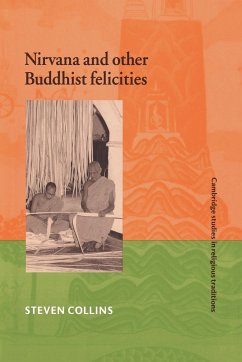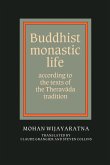Examines the meaning of 'nirvana' and discusses Buddhist utopias, textuality and world history.
This book presents an answer to the question: what is nirvana? Part I distinguishes between systematic and narrative thought in the Pali texts of Theravada Buddhism in South and Southeast Asia, arguing that nirvana produces closure in both, and setting nirvana in the wider category of Buddhist Felicities. Part II explores other Buddhist utopias (both eu-topias, 'good places', and ou-topias, 'no-places'), and relates Buddhist utopianism to studies of European and American utopian writing. The book ends with a close reading of the Vessantara Jataka, which highlights the conflict between the ascetic quest for closure and ultimate felicity, and the ongoing demands of ordinary life and society. Steven Collins discusses these issues in relation to textuality, world history and ideology in premodern civilizations, aiming to contribute to an alternate vision of Buddhist history, which can hold both the inside and the outside of texts together.
Review quote:
"This major publication belongs in all undergraduate and graduate libraries supporting religious studies programs."
John Clifford Holt, Religious Studies Review
"This is a fantastic work. It is highly informative, intriguing, and thoroughly researched. I recommend it without reservation for anyone interested in the Pali literature. The only criticism I have is that the author might have made this one colossal work into a few smaller ones. Otherwise, this is an excellent accomplishment."
Vanessa Sasson, ARC, the Journal of the Faculty of Religious Studies, McGill University
Table of contents:
Preface and Acknowledgements; List of abbreviations; Textual chronology; General introduction: Buddhism and civilisation history I - structures and processes: Part I. Nirvana In and Out of Time: Introduction to part I: systematic and narrative thought - eternity and closure in structure and story; 1. The concept of nirvana; 2. The imagery of nirvana; 3. Nirvana, time and narrative; Conclusion to part I: modes of thought, modes of tradition; Part II. Paradise in Heaven and on Earth: Introduction to part II: utopia and the ideal society; 4. Heaven, the land of Cockaygne and Arcadia; 5. Millennialism; Critical discussion: what is 'millennialism'? Premodern ideas and modern movements; 6. The perfect moral commonwealth? Kingship and its discontents; 7. The Vessantara JÃ¥taka; Conclusion to part II: in what sense can one speak of Buddhist utopianism?; General conclusion: Buddhism and civilisation history II - reprise: Appendices; Bibliography; Glossary; Indexes.
This book presents an answer to the question: what is nirvana? Part I distinguishes between systematic and narrative thought in the Pali texts of Theravada Buddhism in South and Southeast Asia, arguing that nirvana produces closure in both, and setting nirvana in the wider category of Buddhist Felicities. Part II explores other Buddhist utopias (both eu-topias, 'good places', and ou-topias, 'no-places'), and relates Buddhist utopianism to studies of European and American utopian writing. The book ends with a close reading of the Vessantara Jataka, which highlights the conflict between the ascetic quest for closure and ultimate felicity, and the ongoing demands of ordinary life and society. Steven Collins discusses these issues in relation to textuality, world history and ideology in premodern civilizations, aiming to contribute to an alternate vision of Buddhist history, which can hold both the inside and the outside of texts together.
Review quote:
"This major publication belongs in all undergraduate and graduate libraries supporting religious studies programs."
John Clifford Holt, Religious Studies Review
"This is a fantastic work. It is highly informative, intriguing, and thoroughly researched. I recommend it without reservation for anyone interested in the Pali literature. The only criticism I have is that the author might have made this one colossal work into a few smaller ones. Otherwise, this is an excellent accomplishment."
Vanessa Sasson, ARC, the Journal of the Faculty of Religious Studies, McGill University
Table of contents:
Preface and Acknowledgements; List of abbreviations; Textual chronology; General introduction: Buddhism and civilisation history I - structures and processes: Part I. Nirvana In and Out of Time: Introduction to part I: systematic and narrative thought - eternity and closure in structure and story; 1. The concept of nirvana; 2. The imagery of nirvana; 3. Nirvana, time and narrative; Conclusion to part I: modes of thought, modes of tradition; Part II. Paradise in Heaven and on Earth: Introduction to part II: utopia and the ideal society; 4. Heaven, the land of Cockaygne and Arcadia; 5. Millennialism; Critical discussion: what is 'millennialism'? Premodern ideas and modern movements; 6. The perfect moral commonwealth? Kingship and its discontents; 7. The Vessantara JÃ¥taka; Conclusion to part II: in what sense can one speak of Buddhist utopianism?; General conclusion: Buddhism and civilisation history II - reprise: Appendices; Bibliography; Glossary; Indexes.








